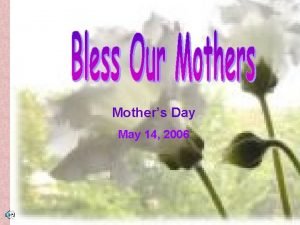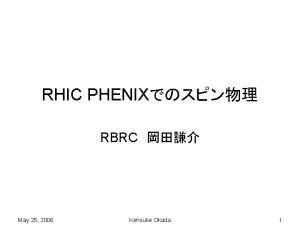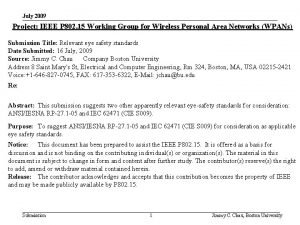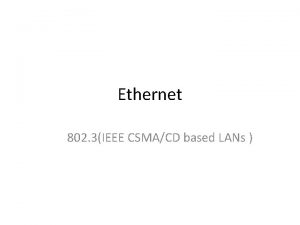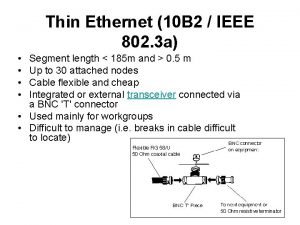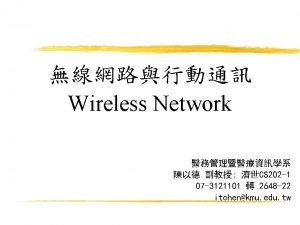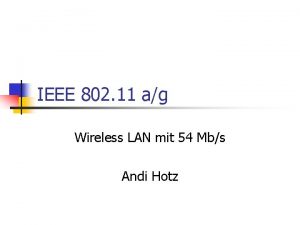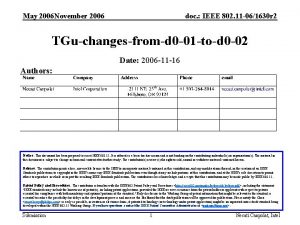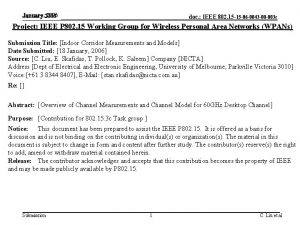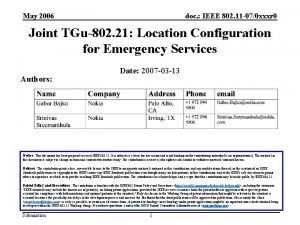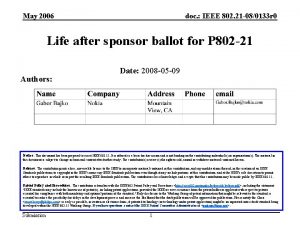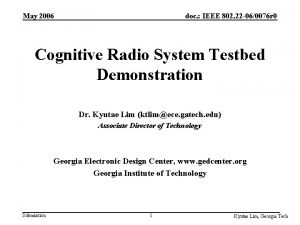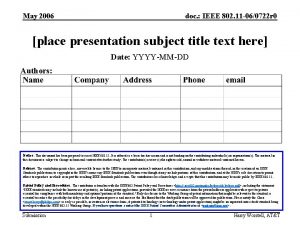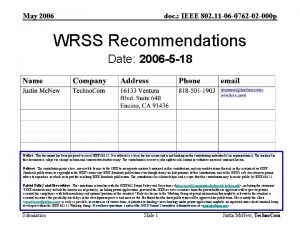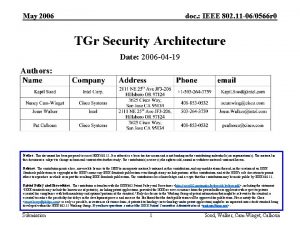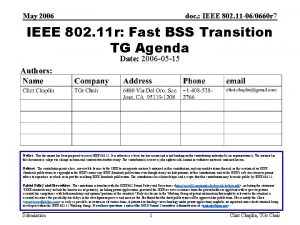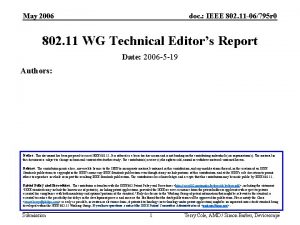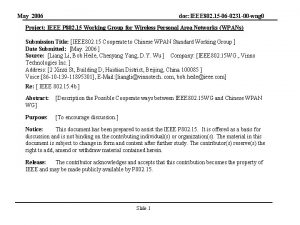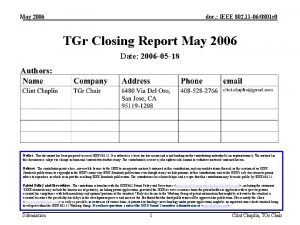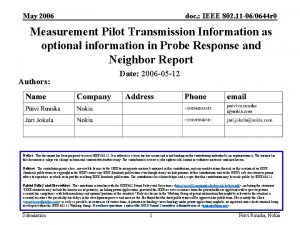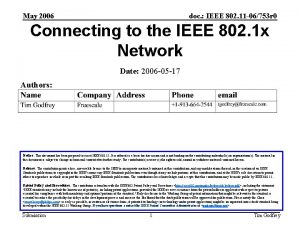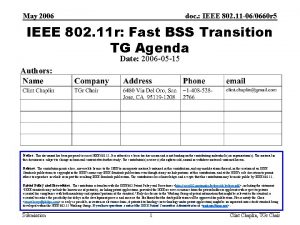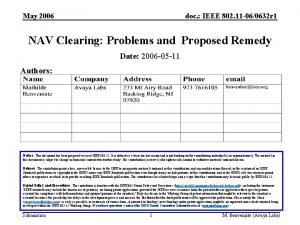May 2006 doc IEEE 802 11 060608 r




















- Slides: 20

May 2006 doc. : IEEE 802. 11 -06/0608 r 2 Extension Channel CCA Proposed Solutions Authors: Date: 2006 -05 -04 Notice: This document has been prepared to assist IEEE 802. 11. It is offered as a basis for discussion and is not binding on the contributing individual(s) or organization(s). The material in this document is subject to change in form and content after further study. The contributor(s) reserve(s) the right to add, amend or withdraw material contained herein. Release: The contributor grants a free, irrevocable license to the IEEE to incorporate material contained in this contribution, and any modifications thereof, in the creation of an IEEE Standards publication; to copyright in the IEEE’s name any IEEE Standards publication even though it may include portions of this contribution; and at the IEEE’s sole discretion to permit others to reproduce in whole or in part the resulting IEEE Standards publication. The contributor also acknowledges and accepts that this contribution may be made public by IEEE 802. 11. Patent Policy and Procedures: The contributor is familiar with the IEEE 802 Patent Policy and Procedures <http: // ieee 802. org/guides/bylaws/sb-bylaws. pdf>, including the statement "IEEE standards may include the known use of patent(s), including patent applications, provided the IEEE receives assurance from the patent holder or applicant with respect to patents essential for compliance with both mandatory and optional portions of the standard. " Early disclosure to the Working Group of patent information that might be relevant to the standard is essential to reduce the possibility for delays in the development process and increase the likelihood that the draft publication will be approved for publication. Please notify the Chair <stuart. kerry@philips. com> as early as possible, in written or electronic form, if patented technology (or technology under patent application) might be incorporated into a draft standard being developed within the IEEE 802. 11 Working Group. If you have questions, contact the IEEE Patent Committee Administrator at <patcom@ieee. org>. Submission 1 Srinivas Kandala, Airgo Networks, Inc.

May 2006 doc. : IEEE 802. 11 -06/0608 r 2 Abstract In this presentation, we study the possible solutions to improve the co-existence between an IEEE 802. 11 n network in the 40 MHz and a legacy IEEE 802. 11 network in the extension channel. Three alternative solutions are provided and through simulations we show the effect on the network throughput due to each of the co-existence mechanisms. Submission 2 Srinivas Kandala, Airgo Networks, Inc.

May 2006 doc. : IEEE 802. 11 -06/0608 r 2 Three Alternatives 1. Major / Significant Impact on Legacy Operation in Ext Ch • No CCA on extension channel • Dramatic negative impact on throughput of both HT and Legacy devices 2. Slight Impact on Legacy Operation in Ext Ch • Mandatory independent CCA on both Control and extension channel (ED CCA for ext ch) • Mandatory to avoid 40 MHz transmissions when ext ch CCA is busy • Relatively Fair Sharing of Medium ED = Energy Detect, CCA = Clear Channel Assessment Submission 3 3. Minimal Impact on Legacy Operation in Ext Ch • Mandatory independent CCA on both Control and extension channel (ED CCA for ext ch) • Mandatory to avoid 40 MHz transmissions when ext ch CCA is busy • Independent back-off counters for both Control and Ext Channels • Including back off counter for ext ch provides some improvements in favor of legacy networks over alt. 2 Srinivas Kandala, Airgo Networks, Inc.

May 2006 doc. : IEEE 802. 11 -06/0608 r 2 Simulations • The three alternatives are studied using simulations. • For each alternative, the simulations are set up in the following manner: – Run one UDP flow from a 20/40 MHz to another 20/40 MHz station. – Run two UDP flows from a 20 MHz legacy station to another 20 MHz legacy station – Vary the offered load on the legacy UDP flows. Submission 4 Srinivas Kandala, Airgo Networks, Inc.

May 2006 doc. : IEEE 802. 11 -06/0608 r 2 Simulation scenarios Scenario 1 (No CCA on Extension Channel): • 20/40 station contends for the channel based on the backoffs (and CCA) performed on the control channel. The carrier of the extension channel is not sensed • 20 MHz stations contend for the extension channel based on the backoffs (and CCA) • 20 MHz stations are also assumed to be capable of detecting a 40 MHz transmission and backoff if the (extension) channel is busy Submission 5 Srinivas Kandala, Airgo Networks, Inc.

May 2006 doc. : IEEE 802. 11 -06/0608 r 2 Simulation scenarios • Scenario 2 (CCA on Extension Channel): • 20/40 station contends for the channel based on the backoffs (and CCA) performed on the control channel. In parallel, the station keeps track of the CCA on extension channel. – When the backoff on the control channel expires and the extension channel has been idle for at least a duration of PIFS, the 20/40 stations transmits using a 40 MHz signal. – When the backoff on the control channel expires and the extension channel is busy or extension channel is idle only for a duration of less than the PIFS, the station transmits using the 20 MHz signal • 20 MHz stations contend for the extension channel based on the backoffs (and CCA) • 20 MHz stations are also assumed to be capable of detecting a 40 MHz transmission and backoff Submission 6 Srinivas Kandala, Airgo Networks, Inc.

May 2006 doc. : IEEE 802. 11 -06/0608 r 2 Simulation scenarios • Scenario 3 (Backoff on Extension Channel): • 20/40 station contends for the channel based on the backoffs (and CCA) performed on the control channel. In parallel, the station runs a separate backoff engine based on the CCA on the extension channel. – When the backoff on the control channel expires and if the backoff counter on the extension channel has counted down to 0 and the channel has been idle for at least a duration of PIFS, the 20/40 stations transmits using a 40 MHz signal. – When the backoff on the control channel expires and the extension channel is busy or is in a backoff or the extension channel is idle only for a duration of less than the PIFS, the station transmits using the 20 MHz signal • 20 MHz stations contend for the extension channel based on the backoffs (and CCA) • 20 MHz stations are also assumed to be capable of detecting a 40 MHz transmission and backoff Submission 7 Srinivas Kandala, Airgo Networks, Inc.

May 2006 doc. : IEEE 802. 11 -06/0608 r 2 Simulation Parameters Parameter Value CWmin/CWmax 15/1023 Retry Limit 7 40 MHz HT Data rate 270 Mbps 20 MHz HT Data rate 130 Mbps 20 MHz extension Data rate (No Qo. S) 54 Mbps AIFSN (on 11 n STA transmissions) 3 TXOP Size (on 11 n STA Transmissions) 0 Number of MPDUs in A-MPDU (in 11 n STA transmissions) 5 or 10 Number of UDP flows in 40 MHz 1 (others are also simulated) Number of UDP flows in extension 1 or 2 (others are also simulated) PER on either transmissions 1% Submission 8 Srinivas Kandala, Airgo Networks, Inc.

May 2006 doc. : IEEE 802. 11 -06/0608 r 2 Impacts of CCA and Back-Off on Extension Channel Operation (Fully Loaded Networks, A-MPDU=5, One flow on Legacy Network) Max Goodput for 40 MHz. 11 n (138 Mbps) Max Goodput for 20 MHz. 11 n (87 Mbps) Max Goodput for Legacy (30 Mbps) Simulation Assumptions: Submission TXOP = O, One 40 MHz UDP flow fully loaded, One 20 MHz UPD flow on extension channel in legacy network fully loaded, A-MPDU = 5, Random PER 1% 9 Srinivas Kandala, Airgo Networks, Inc.

May 2006 doc. : IEEE 802. 11 -06/0608 r 2 Impacts of CCA and Back-Off on Extension Channel Operation (20% loading of Legacy Network, A-MPDU=5, One flow on legacy network) Max Goodput for 40 MHz. 11 n (138 Mbps) Max Goodput for 20 MHz. 11 n (87 Mbps) Max Goodput for Legacy (6 Mbps) Simulation Assumptions: Submission TXOP = O, One 40 MHz UDP flow fully loaded, One 20 MHz UPD flow on extension channel in legacy network fully loaded, A-MPDU = 5, Random PER 1% 10 Srinivas Kandala, Airgo Networks, Inc.

May 2006 doc. : IEEE 802. 11 -06/0608 r 2 Impact of CCA and Back-Off in Extension Channel (A-MPDU=5, One flow on legacy network, multiple legacy network traffic loading scenarios) Simulation Assumptions: Submission TXOP = O, One 40 MHz UDP flow fully loaded, One 20 MHz UPD flow on extension channel in legacy network 20%, 40%, 60%, 80%, 100% loaded, A-MPDU = 5, Random PER: 1% 11 Srinivas Kandala, Airgo Networks, Inc.

May 2006 doc. : IEEE 802. 11 -06/0608 r 2 Conclusions • Alternatives 2 and 3 clearly allow the IEEE 802. 11 n stations to share the channel with legacy transmissions on the extension channel in a fair manner – Alternative 3 is clearly the fairest • When the load on the extension channel is light or even moderate, the benefits of using IEEE 802. 11 n using 40 MHz can be achieved. • We welcome further discussion regarding finding a solution for the 40 Mhz interoperability / coexistence problem, based on the results from these simulations Submission 12 Srinivas Kandala, Airgo Networks, Inc.

May 2006 doc. : IEEE 802. 11 -06/0608 r 2 • Back Up Submission 13 Srinivas Kandala, Airgo Networks, Inc.

May 2006 doc. : IEEE 802. 11 -06/0608 r 2 Impacts of CCA and Back-Off on Extension Channel Operation (Fully Loaded Networks, A-MPDU=5, 2 flows on Legacy Network) Max Goodput for 40 MHz. 11 n (138 Mbps) Max Goodput for 20 MHz. 11 n (87 Mbps) Max Goodput for Legacy (30 Mbps) Simulation Assumptions: Submission TXOP = O, One 40 MHz UDP flow fully loaded, 2 x 20 MHz UPD flow on extension channel in legacy network fully loaded, A-MPDU = 5, Random PER 1% 14 Srinivas Kandala, Airgo Networks, Inc.

May 2006 doc. : IEEE 802. 11 -06/0608 r 2 Impacts of CCA and Back-Off on Extension Channel Operation (20% loading of. Legacy Network, A-MPDU=5, 2 flows on legacy network) Max Goodput for 40 MHz. 11 n (138 Mbps) Max Goodput for 20 MHz. 11 n (87 Mbps) Max Goodput for Legacy (6 Mbps) Simulation Assumptions: Submission TXOP = O, One 40 MHz UDP flow fully loaded, 2 x 20 MHz UPD flow on extension channel in legacy network fully loaded, A-MPDU = 5, Random PER 1% 15 Srinivas Kandala, Airgo Networks, Inc.

May 2006 doc. : IEEE 802. 11 -06/0608 r 2 Impact of CCA and Back-Off in Extension Channel (A-MPDU=5, multiple legacy network traffic loading scenarios) Simulation Assumptions: Submission TXOP = O, One 40 MHz UDP flow fully loaded, 2 x 20 MHz UPD flow on extension channel in legacy network 20%, 40%, 60%, 80%, 100% loaded, A-MPDU = 5, Random PER: 1% 16 Srinivas Kandala, Airgo Networks, Inc.

May 2006 doc. : IEEE 802. 11 -06/0608 r 2 Impacts of CCA and Back-Off on Extension Channel Operation (Fully Loaded Networks, A-MPDU=10) Max Goodput for 40 MHz. 11 n (179 Mbps) Max Goodput for 20 MHz. 11 n (102 Mbps) Max Goodput for Legacy (30 Mbps) Simulation Assumptions: Submission TXOP = O, 1 40 MHz UDP flow fully loaded, 2 x 20 MHz UPD flow on extension channel in legacy network fully loaded, A-MPDU = 5, Random PER 1% 17 Srinivas Kandala, Airgo Networks, Inc.

May 2006 doc. : IEEE 802. 11 -06/0608 r 2 Impacts of CCA and Back-Off on Extension Channel Operation (20% loading of. Legacy Network, A-MPDU=10) Impact of CCA and Back Off on Ext Channel on. 11 n 40 MHz and Legacy Operation (UDP goodput in Mbps) 180 - 20% Loading of Extension Channel Legacy Network (6 Mbps), A-MPDU = 10 Max Goodput - for 40 MHz. 11 n (179 Mbps) 151. 8 160 135. 2 140 120 100 80 40 MHz Operation Max Goodput for 20 MHz. 11 n (102 Mbps) 79. 0 60 Legacy 20 MHz Operation 40 20 5. 0 0 No CCA on Ext Ch Simulation Assumptions: Submission 5. 9 CCA on Ext Ch 5. 9 CCA and Back-Off on Ext Ch Max Goodput for Legacy Operation (6 Mbps) TXOP = O, 1 40 MHz UDP flow fully loaded, 2 x 20 MHz UPD flow on extension channel in legacy network fully loaded, A-MPDU = 10, Random PER 1% 18 Srinivas Kandala, Airgo Networks, Inc.

May 2006 doc. : IEEE 802. 11 -06/0608 r 2 Impact of CCA and Back-Off in Extension Channel (A-MPDU=10, multiple legacy network traffic loading scenarios) Simulation Assumptions: Submission TXOP = O, 1 40 MHz UDP flow fully loaded, 2 x 20 MHz UPD flow on extension channel in legacy network 20%, 40%, 60%, 80%, 100% loaded, A-MPDU = 10, Random PER: 1% 19 Srinivas Kandala, Airgo Networks, Inc.

May 2006 doc. : IEEE 802. 11 -06/0608 r 2 References Submission 20 Srinivas Kandala, Airgo Networks, Inc.
 Bridges from 802.x to 802.y
Bridges from 802.x to 802.y Bridges from 802.x to 802.y
Bridges from 802.x to 802.y Modelo ieee 802
Modelo ieee 802 Ieee 802 standard
Ieee 802 standard Bluetooth ieee 802
Bluetooth ieee 802 802 ieee
802 ieee Ieee 802
Ieee 802 Ieee 802 family
Ieee 802 family Ieee 802 3 compliance
Ieee 802 3 compliance Ieee802.22
Ieee802.22 Arquitetura ieee 802
Arquitetura ieee 802 Mothers day 2006
Mothers day 2006 Deped school calendar 2005-2006
Deped school calendar 2005-2006 Okada
Okada Hci patterns may or may not include code for implementation
Hci patterns may or may not include code for implementation 09 802 0561
09 802 0561 Ethernet 802
Ethernet 802 802-3-ethernet
802-3-ethernet 802 family
802 family 802 701
802 701 Wireless lan 802
Wireless lan 802











